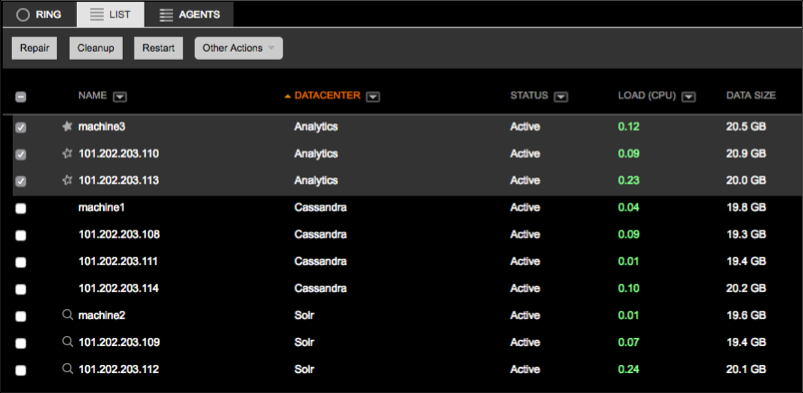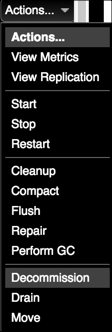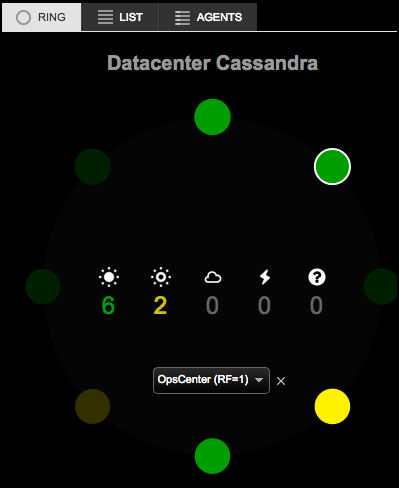Node management operations
Use OpsCenter to run operations on nodes in an easy to use, visual way that takes the guesswork out of properly managing nodes in a cluster.
Managing multiple nodes
Use OpsCenter to run operations (or actions) on nodes in an easy to use, visual way that takes the guesswork out of properly managing nodes in a cluster. Most node management operations can be run on multiple nodes of your choosing (for example, all the nodes in a cluster, all the nodes in a single datacenter, or a handful of problem nodes). The operations run in a rolling fashion and do not continue on to the next node until the previous one has completed successfully. If the operation fails on a node, the entire process stops.
To run an operation on multiple nodes (bulk operations), select those nodes in List View and choose an appropriate action.

Notifications appear when an operation starts and completes. Clicking Show Details takes you to the Activities page.

Managing single nodes
To run an operation on a single node, click that node from Ring View or List View and choose an action from the Actions menu from the node details dialog:

Operations details
- View Metrics (single node only)
- Redirects you to the Dashboard area of OpsCenter where you can select metrics graphs and configure performance views for the selected node.
- View Replication (ring view, single datacenter only)
- Shows the replication relationships between the selected node and other nodes in the
cluster, based on the selected keyspace.

- Restart
- Restarts the DataStax Enterprise process on a
node. If running restart on multiple nodes, each node is started as soon as the start
command for the previous node returns. Tip: To run a rolling restart of all nodes in a cluster, select Restart from the Cluster Actions menu.
- Cleanup
- Removes rows for which the node is no longer responsible. Cleanup is usually performed after changing the partitioner tokens or the replication options for a cluster. See Running cleanup.
- Compact
- Performs a major compaction, which is not a recommended procedure for most DataStax Enterprise clusters. See Running compaction.
- Flush
- Flushes to disk as persistent SSTables the recent writes currently stored in memory (memtables). See Flushing tables.
- Repair
- Makes a node consistent with its replicas by doing an in-memory comparison of all the
rows of a table and resolving any discrepancies between replicas by updating outdated
rows with the current data. See Running a manual repair.Warning: Do not run a manual repair operation from Node administration or using the command line while the Repair Service or NodeSync Service is On.
- Perform GC
- Forces the Java Virtual Machine (JVM) on the selected node to perform a garbage collection (GC). See Performing garbage collection.
- Decommission (single node only)
- Removes a node from the cluster and streams its data to neighboring replicas. See Decommission a node.
- Drain (single node only)
- Causes the recent writes currently stored in memory (memtables) to be flushed to disk
as persistent SSTables and then makes the node read-only. The node stops accepting new
writes until DSE is restarted. Draining a node is
usually done when upgrading a node.Note: Draining a node is not necessary with either the OpsCenter UI or the drain nodetool command when upgrading a node to a minor DSE version using LCM.
- Move (single node only)
- Changes the partitioner token assignment for the node, thus changing the range of data that the node is responsible for. Not available if vnodes are enabled. See Moving a node.
